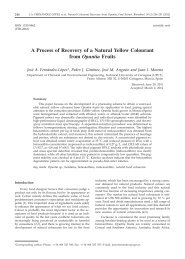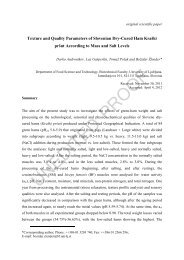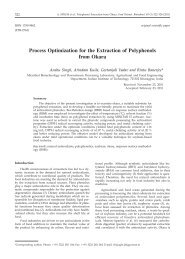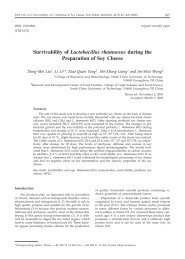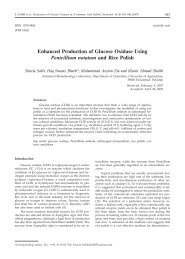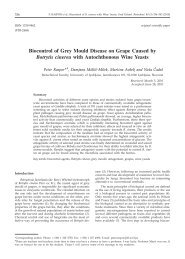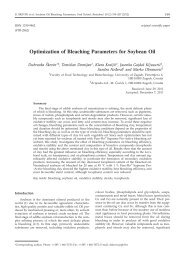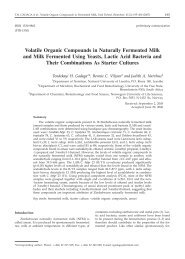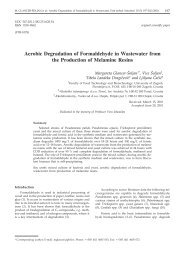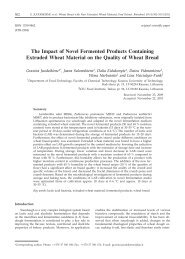148 A. WEISS et al.: <strong>Selective</strong> <strong>Media</strong> <strong>for</strong> <strong>Enumeration</strong> <strong>of</strong> Probiotic Enterococci, <strong>Food</strong> Technol. Biotechnol. 43 (2) 147–155 (2005)gram, provided that it is measurable by an <strong>of</strong>ficial orscientifically valid method (3). Due to <strong>the</strong> importance <strong>of</strong>enterococci in different foods, feeds, clinical and environmentalsamples, numerous media have been used <strong>for</strong><strong>the</strong> detection, isolation and enumeration (4). This studywas per<strong>for</strong>med within an EU project initiated by a DedicatedCall and was based on <strong>the</strong> regulations <strong>of</strong> <strong>the</strong>Council Directive 70/524/EEC (2) concerning additivesin feeds and <strong>the</strong> application <strong>of</strong> probiotics in feeds. Accordingto <strong>the</strong> Official Journal <strong>of</strong> <strong>the</strong> European CommunitiesC 263/3 (5), eleven genera <strong>of</strong> bacteria, three genera<strong>of</strong> yeast and one mould have been approved <strong>for</strong>temporary use within specified member states and arein line with <strong>the</strong> provisions <strong>of</strong> Council Directive 93/113/EC (3).Twelve media were selected based on a literaturesearch (4) and tested with a set <strong>of</strong> strains. The specieswere selected based on <strong>the</strong>ir involvement in probioticanimal feeds as outlined in <strong>the</strong> Official Journal <strong>of</strong> <strong>the</strong>European Communities C 263/3 (5).Material and MethodsTest strainsThe strain set used <strong>for</strong> <strong>the</strong> selectivity test consisted<strong>of</strong> twenty-eight enterococci, eleven lactobacilli, six pediococciand one Streptococcus <strong>the</strong>rmophilus strain (seeTable 1). Lactobacilli, pediococci and S. <strong>the</strong>rmophilus werechosen as <strong>the</strong>y are authorised by <strong>the</strong> EU to be incorporatedin feeds, and are so closely related to enterococcithat <strong>the</strong>y might interfere with <strong>the</strong>ir enumeration.Culturing <strong>of</strong> test strainsThe test strains used were subcultured as follows:enterococci were grown in 10 mL <strong>of</strong> brain heart infusionbroth (BHI, CM 225, Oxoid) under aerobic conditions<strong>for</strong> 24 h at 37 °C. Lactobacilli were grown in MRS broth(1.10661, Merck) under anaerobic conditions (anaerobicchamber; atmosphere: N 2 80 %, CO 2 10 % and H 2 10 %)<strong>for</strong> 24 h at 37 °C. Trypticase soy broth (TS, CM 129, Oxoid)supplemented with 3 g/L <strong>of</strong> yeast extract (1.037753,Merck) was used <strong>for</strong> subculturing <strong>of</strong> <strong>the</strong> S. <strong>the</strong>rmophilusstrain under anaerobic conditions at 32 °C <strong>for</strong> 24 h and<strong>for</strong> pediococci under <strong>the</strong> same conditions <strong>for</strong> 48 h.<strong>Selective</strong> mediaThe tested selective media were prepared accordingto <strong>the</strong> author’s or manufacturers’ guidelines. After sterilisation<strong>the</strong> media were cooled to 50 °C and plates wereprepared by pouring 17 mL <strong>of</strong> sterile medium into a sterilePetri dish. All media used are described below, includingimportant details <strong>of</strong> <strong>the</strong>ir preparation.Bile esculin (BE) agar (CM 888, Oxoid; 44.5 g/L),which was autoclaved <strong>for</strong> 15 min at 121 °C, was applied.Additionally, two bile esculin azide (BEA) agarsfrom different manufacturers were tested: enterococcosel(ECSA) agar (4312205, Becton-Dickinson; 56 g/L,which was autoclaved <strong>for</strong> 15 min at 121 °C) and D-coccosel(D-Cocc) agar (51025, bioMérieux; 56 g/L, whichwas autoclaved <strong>for</strong> 15 min at 121 °C).Table 1. List <strong>of</strong> test strainsStrain Code Genus – species – subspecies O<strong>the</strong>r codeEn1 Enterococcus faecalis DSM 2570En2 E. faecalis DSM 20478En3 E. faecium DSM 2918En4 E. faecium DSM 20477En5 E. durans DSM 20633En6 E. gallinarum DSM 20628En7 E. faecium Own isolateEn8 E. faecium Own isolateEn9 E. faecium Own isolateEn10 E. faecium Own isolateEn11 E. faecium DSM 3320En12 E. faecalis DSM 2981En12A E. faecalis ATCC 14506En13 E. durans ATCC 6056En14 E. faecium ATCC 27270En15 E. faecalis ATCC 27274En16 E. faecium DSM 2146En17 E. faecium DSM 6177En18 E. avium DSM 20679En19 E. casseliflavus DSM 20680En20 E. hirae DSM 20160En21 E. malodoratus DSM 20681En22 E. mundtii DSM 4838En23 E. raffinosus DSM 5633En24 E. faecium DSM 7134En25 E. faecium NCIMB 10415En26 E. faecium NCIMB 11181En27 E. faecium NCIMB 30096En28 E. faecium Own isolateEn30 E. faecium ATCC 19434Lb1 Lactobacillus acidophilus DSM 20079Lb7 L. amylovorus DSM 20531Lb12 L. rhamnosus DSM 20021Lb13 L. reuteri DSM 20016Lb14 L. plantarum Own isolateLb17 L. fermentum ATCC 9338Lb20 L. casei Own isolateLb21 L. reuteri Own isolateLb22 L. casei DSM 20011Lb23 L. plantarum DSM 20174Lb28 L. rhamnosus DSM 7133Sc1 Streptococcus <strong>the</strong>rmophilus DSM 20617Pd1 Pediococcus acidilactici DSM 20248Pd2 P. acidilactici DSM 20238Pd3 P. damnosus DSM 20331Pd4 P. parvulus DSM 20332Pd5 P. dextrinicus DSM 20335Pd6 P. pentosaceus DSM 20336Pd7 P. pentosaceus ATCC 43200Pd8 P. inopinatus DSM 20285
A. WEISS et al.: <strong>Selective</strong> <strong>Media</strong> <strong>for</strong> <strong>Enumeration</strong> <strong>of</strong> Probiotic Enterococci, <strong>Food</strong> Technol. Biotechnol. 43 (2) 147–155 (2005)149Cephalexin aztreonam arabinose (CAA) agar (accordingto Ford et al. (6)) consists <strong>of</strong> Columbia agar base40 g/L, arabinose 10 g/L and phenol red solution 3.6mL/L, m/V=2. The pH value was adjusted to pH=7.8and <strong>the</strong> medium was autoclaved <strong>for</strong> 20 min at 114 °C(0.7 bar). After <strong>the</strong> medium had reached 50 °C, freshsterile solutions <strong>of</strong> aztreonam and cephalexin were addedto reach <strong>the</strong> final concentrations <strong>of</strong> 75 and 50 mg/L,respectively.Chromocult enterococci (CE) agar (1.10294, Merck;Chromocult enterococci broth 18 g/L and agar 14 g/L)was autoclaved <strong>for</strong> 15 min at 121 °C.Citrate azide Tween carbonate (CATC) agar (1.10279,Merck; 56 g/L) was autoclaved <strong>for</strong> 15 min at 121 °C.When <strong>the</strong> medium had reached approximately 50 °C,filter-sterilised solutions were added: 20 mL <strong>of</strong> sodium--hydrogen carbonate m/V=10, 10 mL <strong>of</strong> 2,3,5-triphenyltetrazolium chloride (TTC) solution m/V=1 and 4 mL <strong>of</strong>sodium azide solution m/V=10.mE (mE) agar (0333-17, Difco; 72.1 g/L) was autoclavedat 121 °C <strong>for</strong> 15 min. When <strong>the</strong> medium hadreached a temperature <strong>of</strong> approximately 50 °C, filter--sterilised solutions were added: 15 mL <strong>of</strong> TTC m/V=1and 0.24 g <strong>of</strong> nalidixic acid.Fluorescent gentamicin thallous carbonate (fGTC)agar (according to Littel and Hartman (7)) was obtainedby suspending CASO agar 40 g, potassium-dihydrogenphosphate5 g, amylose azure 3 g, galactose 1 g, thalliumazure 0.5 g, 4-methyl umbelliferyl-a-D-galactoside100 mg and 0.75 mL <strong>of</strong> Tween ® 80in1L<strong>of</strong>distilled waterand mixing thoroughly. Then 2.5 mL <strong>of</strong> gentamicinsolution (1 mg/mL) were added and autoclaved <strong>for</strong> 15min at 121 °C. When <strong>the</strong> medium had reached a temperature<strong>of</strong> approximately 55 °C, 20 mL <strong>of</strong> filter-sterilisedsodium hydrogen carbonate solution (m/V=10) wereadded.Kanamycin esculin azide (KEA) agar (CM 591, Oxoid;42.6 g/L) was obtained by adding two vials <strong>of</strong> kanamycinsupplement (SR92, Oxoid), and <strong>the</strong>n autoclaved <strong>for</strong>15 min at 121 °C.KF-streptococcus (KF) agar (CM 701, Oxoid; 76.4g/L) was autoclaved at 121 °C <strong>for</strong> 10 min. When <strong>the</strong>medium had reached 50 °C, 10 mL <strong>of</strong> filter-sterilisedTTC solution (m/V=1) were added.Membrane-filter enterococcus selective (SB) agar(according to Slanetz and Bartley (8); 1.05289, Merck;41.5 g/L) was sterilised by heating in a current <strong>of</strong> steamin an autoclave without excess pressure <strong>for</strong> 20 min.When <strong>the</strong> medium had cooled to approximately 50 °C,10 mL <strong>of</strong> filter-sterilised TTC (m/V=1) were added.Merckoplate Barnes (BA) agar (13576, Merck; ready--to-use plates) was used.Oxolonic acid esculin azide (OAA) agar (accordingto Audicana et al. (9)) was obtained by suspending 42.6g <strong>of</strong> kanamycin esculin azide agar (CM 591, Oxoid) and0.25 g <strong>of</strong> sodium azide in 1 L and <strong>the</strong>n autoclaved <strong>for</strong> 15min at 121 °C. Oxolonic acid (0.1 g) was dissolved in 5mL <strong>of</strong> 0.1 M NaOH and filter-sterilised. The aliquots <strong>of</strong><strong>the</strong> solution (1 mL <strong>of</strong> each) were stored at –20 °C. When<strong>the</strong> medium had reached a temperature <strong>of</strong> approximately45 °C, 0.5 mL <strong>of</strong> oxolonic acid solution wereadded under aseptic conditions.Sterile media in Petri dishes, protected against dehydration,were stored <strong>for</strong> up to two weeks at a temperature<strong>of</strong> 4 °C.Evaluation <strong>of</strong> selective mediaBased on a comprehensive literature review (4), <strong>the</strong>cited media were grouped according to <strong>the</strong>ir selectivecomponents. Already well-evaluated, mainly commerciallyavailable media were selected out <strong>of</strong> <strong>the</strong> maingroups to test <strong>the</strong>ir selectivity with a set <strong>of</strong> enterococciand strains <strong>of</strong> genera <strong>of</strong> o<strong>the</strong>r lactic acid bacteria. Thesubcultured strains were loop-streaked onto <strong>the</strong> agarplates. After incubation under aerobic conditions <strong>for</strong> 24h (BE, ECSA, D-Cocc, CAA, CATC, fGTC, KEA, SB, BA,OAA) or <strong>for</strong> 48 h (CE, mE, KF), <strong>the</strong> growth <strong>of</strong> <strong>the</strong> teststrains was evaluated. The colony size was measured(<strong>for</strong> parameters see Tables 2 and 3), <strong>the</strong>n <strong>the</strong> growthwas described, and digital photographs <strong>of</strong> <strong>the</strong> wholeplates and close ups (microscope SZH10, Olympus) <strong>of</strong>single colonies were taken (data not shown).Comparative testing <strong>of</strong> three selective mediaand BHI agarIn order to set up a protocol <strong>for</strong> <strong>the</strong> enumeration <strong>of</strong>enterococci in feeds and feed supplements, <strong>the</strong> threemost selective media (ECSA, mE and CATC) were chosenand included in fur<strong>the</strong>r trials. Their per<strong>for</strong>mancewas compared with <strong>the</strong> non-selective control mediumBHI concerning <strong>the</strong>ir productivity. The productivity wascalculated according to <strong>the</strong> following <strong>for</strong>mula:N ssP =N Nsss0/1/number <strong>of</strong> colonies <strong>of</strong> <strong>the</strong> sought type obtained onselective mediumsN 0 number <strong>of</strong> colonies <strong>of</strong> <strong>the</strong> sought type obtained oncontrol mediumFrom a liquid culture <strong>of</strong> <strong>the</strong> strain E. faecium En24(contained in <strong>the</strong> feed supplement »Provita – LE«) oneloop was transferred into sterile BHI broth, blended andincubated under aerobic conditions <strong>for</strong> 24 h at 37 °C. Avolume <strong>of</strong> 1 mL <strong>of</strong> this turbid broth was used to preparea single series <strong>of</strong> decimal dilutions up to <strong>the</strong> dilution <strong>of</strong>1:10 7 . The dilutions <strong>of</strong> 1:10 5 , 1:10 6 and 1:10 7 were used toinoculate plates <strong>of</strong> <strong>the</strong> tested selective media and BHI(two parallel plates per dilution) using <strong>the</strong> surface platingmethod. The inverted plates were incubated underaerobic conditions <strong>for</strong> 24 h at 37 °C. The colony-<strong>for</strong>mingunits (CFU) were determined right after <strong>the</strong> incubation.The arithmetic means <strong>of</strong> <strong>the</strong> colony counts <strong>of</strong> <strong>the</strong>plates with <strong>the</strong> optimum dilution (between 5 and 300colony-<strong>for</strong>ming units per plate) and <strong>the</strong> productivitieswere calculated. The experiment was repeated with modifications(mE agar was no more included, <strong>the</strong> dilutions<strong>of</strong> 1:10 6 , 1:10 7 and 1:10 8 were applied <strong>for</strong> inoculation,three plates were inoculated at <strong>the</strong> same time <strong>for</strong><strong>the</strong> dilution <strong>of</strong> 1:10 7 and two plates <strong>for</strong> each <strong>of</strong> <strong>the</strong> o<strong>the</strong>rdilutions).




